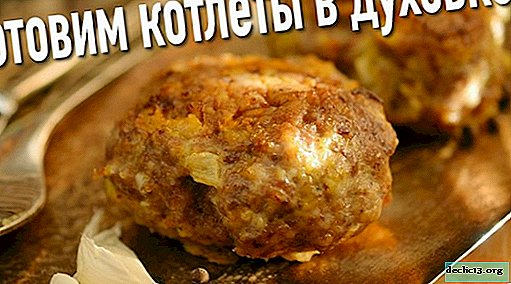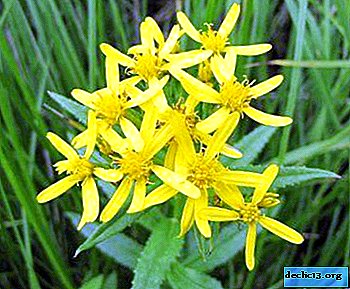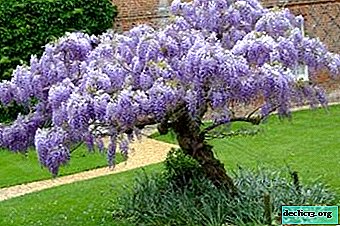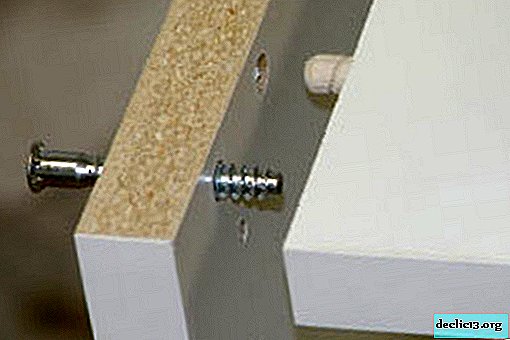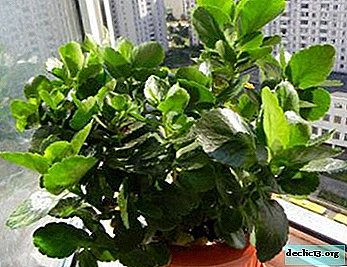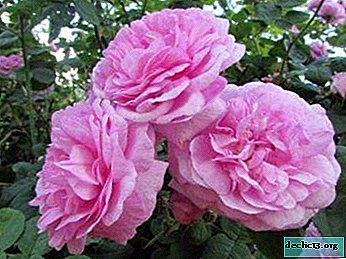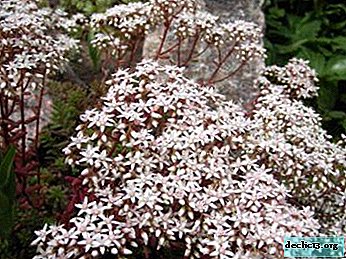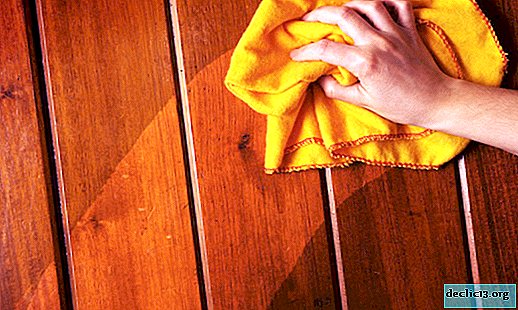Effective ways to get rid of whiteflies on indoor flowers. Reasons for occurrence and preventive measures
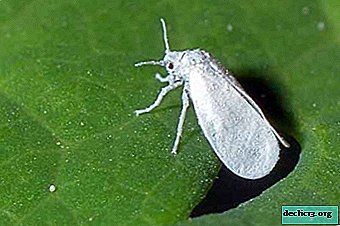
Whitefly is a very unpleasant pest, causing great damage to plants. Fighting her is not easy, but still possible. This will require considerable effort, because getting rid of an insect is not so simple.
There are many existing drugs to deal with this pest. This article describes in detail the effect of each drug, and also gives useful recipes for a folk remedy for fighting whiteflies.
What you need to know about the pest?
This little light sucking moth is very tenacious. It has white wings, and its size is about 3 mm. in length. The larvae that the whitefly lays are pulling juices from garden and indoor plants.
A clear sign of the presence of the parasite is a white cloud of flying insects near the leaves of the plant.Often among the symptoms are:
- yellow leaves folded into tubules;
- sticky coating;
- dark spots.
On the back of the leaves there may be translucent formations that are insect larvae.
If you see white midges in the house, you need to check all indoor plants for the presence of whiteflies.
Reasons for appearing on flowers
This insect can fly. Therefore, it can easily get into the house through a door or window. Also their larvae can enter a room with new soil or a new flowerfrom which other plants will subsequently become infected.
Whiteflies love heat, high humidity, dampness and the close arrangement of plants on window sills and in the corners of rooms. Often these parasites attack greenhouses, because there are ideal conditions for their growth and reproduction.
Photo
The photo shows how a plant affected by a whitefly looks.



How to fight?
If a whitefly is found in the house, it is necessary to carefully examine all the plants and create a quarantine for the infected flowers.
Chemicals and their prices
Tanrek
Intestinal contact insecticide. Tanrek is an effective remedy against many parasites, pests, including aphids.Is produced:
- in ampoules with a water-soluble concentrate of 1.5 ml., ampoules of 1 ml .;
- vials of 10 ml., vials of 50 ml., 100 ml .;
- 1 liter cans
 pros:
pros:
- Blocks nerve receptors and central nervous system parasites, causing death.
- Has a protective period of up to one month.
- It enters the leaves, but not the fruits.
- It can be used in microdoses for vegetables.
- Can be combined with many other drugs.
- Keeps long in the soil and has a long half-life.
- Low price.
- Lack of smell.
- Easy to get divorced.
Minuses:
- Has 3 hazard class.
- Not valid for ticks.
- Rarely: phototoxicity for some plants.
- Danger to bees.
- Do not spray strawberries and strawberries.
- Missing scale on bottles.
Instructions for use:
- Pour 1 liter into a plastic bucket. water.
- Take a syringe and measure 5 ml. facilities.
- Stir thoroughly in water.
- Add water to a volume of 10 liters.
- Pour into a sprayer.
- Gently spray on the surface of the leaves of the plant.
Prices: from 78r to 100r per 1 ml.
Teppeki
Polish insecticide in the form of water-dispersible granules. Moving along the vascular system of the plant, the Teppeki insecticide penetrates all its cells, which ultimately leads to poisoning of the insect that feeds on the juices of this plant.
 pros:
pros:
- Once in the body of an insect, it begins to act after 30 minutes.
- Not addictive.
- It reveals hidden insects.
- Compatible with other pesticides and agrochemicals.
Minuses: dangerous for bees.
Instructions for use:
- Work in dry, calm weather.
- Take 3 ml. facilities.
- Dilute in a 10 liter bucket.
- Spray onto plants.
Prices: from 200r to 300r per 100 gr.
Fitoverm
Biological product for mass insect infestation. A means of salvation not only for the present harvest, but also for the future. Fitoverm can process plants 1-3 days before blooming and pollinator emergence.
 pros:
pros:
- Suitable for trees and berry bushes.
- You can pollinate buds that have not yet opened.
- No phototoxicity.
- Long lasting effect.
- In an environment with 100% humidity or in water, its decay is doubled.
If treatment with Fitoverm was carried out at a temperature above +15 degrees in the evening, then the day after tomorrow it is already possible to release bees.
Minuses:
- Delayed action. Insects will feed from 4 to 24 hours and only then die.
- Not suitable for very gluttonous pests.
- Poor interaction with other insecticides.
Instructions for use:
- Take non-enameled containers.
- Pour the drug - 2 ml.
- Add water - 1 liter.
- Stir until completely dissolved.
- Pour the mixture into the spray gun.
- The crown, branches, trunks, fruits and the first tillering unit are treated with an adhesive base.
For an adhesive base, a large piece of laundry soap is rubbed on a fine grater, the chips are added to hot water, bred to the state of gruel.
- Spray the product.
- Repeat after 7 days.
Prices: from 12 p. up to 20r for 4 gr.
Confidor
The German insecticide Confidor infects the gastrointestinal system of parasites. It is used when spraying plants and the soil around seedlings.
 pros:
pros:
- rapid exposure to pests;
- defeat of hidden living pests;
- compatibility with mineral agrochemicals;
- resistance to flushing with water.
Minuses:
- Hazardous to health.
- Not compatible with other drugs.
- Useless against a tick.
- Acts on adults, but not on larvae.
Instructions for use:
- Dilute 1 ml. funds for 10 liters. water.
- Stir the concentrate.
- Spray plants after planting or before flowering.
Prices: from 50 r to 20 r per 5 ml.
Aktara
Dutch fast-acting and effective insecticide of a new generation. They process not only adult trees and shrubs, but also seedlings of vegetable crops before planting.
 pros:
pros:
- Economically.
- It does not depend on weather conditions.
- Not addictive in insects.
- Valid for a long time.
Minuses:
- Danger to bees.
- Do not store the finished solution.
- Incompatible with other insecticides.
Instructions for use:
- A capacity of at least 1.5-2 liters is taken.
- The contents of a 4g sachet are poured into it.
- Add 1 liter. water.
- Mix thoroughly.
- Bring the water level to 5 liters.
- Spray the plants.
Prices: from 38 r to 150 r per 1 ml.
Actellic
Actellik is a non-systemic drug that interacts in contact, directly with the pest. This is one of the important advantages, since the product does not harm the plant itself, acts only on insects and ticks. Systemic drugs penetrate plant tissue and act on “enemies” when they feed on them.
 pros:
pros:
- Affects both ticks and insects.
- Disinfection of premises.
- Short exposure.
- Prevents re-emergence of "enemies."
- It is gentle to plants.
Minuses:
- Danger for wasps and bees.
- Poor interaction with other insecticides.
Instructions for use:
- Bred in this proportion: 2 ml. poison per liter of water.
- Put a spray bottle on the container.
- Process plants.
Prices: from 76 r to 200 r for 50 gr.
Match
An insecticide, an inhibitor of chitin synthesis, for protection against Larvae of Lepidoptera, Lepidoptera and Orthoptera.
 pros:
pros:
- Prevents hatching of larvae from eggs.
- Reduces the fertility of females in subsequent generations.
- Not toxic to plants in tested application rates.
- Resistant to weather.
- Protective effect of 28 days.
Minuses:
- Danger for wasps, bees and bumblebees.
- Poor interaction with other insecticides.
Instructions for use:
- Dilute 1 ml. funds for 10 liters. water.
- Stir the concentrate thoroughly.
- Spray plants after planting or before flowering.
Prices: from 3000r to 5000r for 1 liter.
Uploud
A powerful insecticide against greenhouse whiteflies, an inhibitor of chitin synthesis, directed against a number of insect pests, contact-intestinal action.
 pros:
pros:
- Long action.
- Additional effect on evaporation.
- Not phototoxic.
- Safe for fish and bees.
Minuses: poor interaction with other insecticides.
Instructions for use:
- Dilute the product in a ratio of 1 mg per 1 liter of water.
- Spray the leaves.
Wash hands thoroughly with soap and water after work.
Prices: from 150 r to 500 r per 100 gr.
Biotlin
A quick-acting garden insecticide that is active against most half-winged garden pests, mainly aphids and its most aggressive subspecies, phylloxera.
 pros:
pros:
- Not harmful to earthworms.
- Not addictive.
Minuses: toxic to fish.
Instructions for use:
- Dilute the drug with water at a rate of 1: 2.
- Spray plants from a spray bottle.
Prices: from 150 r for 5 ml.
Glue traps
 Biotechnological plant protection product.
Biotechnological plant protection product.
pros:
- Cheap.
- Simply.
- Effectively.
Minuses: dangerous for bees.
Instructions for use:
- Set traps at a level of 20-25cm from the upper leaves of plants.
- The traps are attached using twine to the structural elements of greenhouses at the rate of 1 trap per 5-7 m2 of area.
- Change as insects stick.
- Spent traps burn.
Prices: from 60 rub. a piece.
Benzyl benzoate
 Emulsion for external use 20%.
Emulsion for external use 20%.
pros:
- Cheap.
- There is in any pharmacy.
- Effectively.
Minuses:
- Allergy or intolerance to any of the components that make up the benzyl benzoate.
- May cause itching, burning, redness, rash.
Instructions for use:
- Wear protective gloves.
- Take thick sheets of cardboard.
- Spread them with benzyl benzoate.
- Hang over leaves or spread around plants.
Prices: from 15r. up to 100r. in any pharmacy
How to withdraw folk remedies?
Destroy using traps
Bright ribbons to attract the attention of whiteflies and other insects.
 pros:
pros:
- Cheap.
- Can be made from improvised means.
- Safely.
Minuses: time consuming.
Instructions for use:
- We take a thick cardboard.
- We prepare a mixture of castor oil, petroleum jelly, honey and pine rosin in 1: 1 proportions. You can add a bright dye.
- Stir until smooth.
- We spread cardboard.
- We hang over the leaves of plants.
How to get rid of the fumigator?
A device that works on the principle of fumigation, that is, poisons insects with toxic fumes.
 pros:
pros:
- A wide range of.
- High efficiency.
- Low cost.
- No contact with the body of a harmful substance.
- No smell.
Minuses:
- Low service life.
- The need to ventilate the room.
- Contraindications for pregnant women.
- Possible allergic reactions.
Instructions for use: Depending on the type of fumigator, plug the device into a power outlet or light it on a special stand.
Methods of fighting a grenade
- If pomegranate grows in a pot, then the container can be put on its side in the bath.
- Turn on a cold shower and rinse the plant for 5 minutes on all sides.
- Then remove all damaged leaves.
- You can dilute tar soap in a ratio of 1: 6 with cold water and water the leaves of the plant.
Preventative measures
- Disinfect the premises once a year.
- Remove weeds.
- Carefully choose the seeds when buying.
- Avoid stagnation of water.
- Leave space between plants.
- Ventilate the room more often.
Carefulness and daily inspection of plants will help to maintain their beauty for a long time and notice pests in time.

